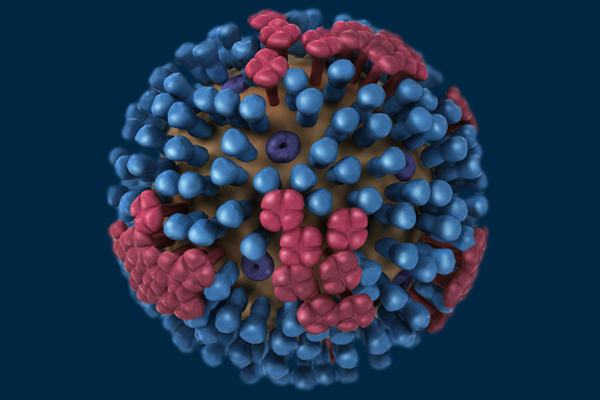Exploring 4 Mysteries of the Flu Virus

Researchers funded by the National Institutes of Health have been asking questions about treating and preventing the flu — and using a variety of approaches to explore answers. Some of their studies focus on understanding the molecular structure of the flu virus; others use computers to model how flu infection can spread.
Structure Reveals One-Time Vaccine Target
The annual flu vaccine usually includes a mixture of the influenza A and B strains that are most likely to cause seasonal epidemics. The vaccine works by triggering your body's production of antibodies that recognize and neutralize the virus. Unfortunately for us, the flu virus evolves quickly, meaning that the antibodies you developed last year may not protect against this year's altered viruses — and that you need a new shot each year.
Many researchers at NIH, universities and medical schools are looking for antibodies that act on a broad range of flu strains, with the goal of understanding how they attach to the viruses and then designing vaccines or other flu therapies that produce a similar effect. One group, an international team that includes scientists at the Scripps Research Institute, has identified a human antibody that provides protection against influenza A and B strains — at least in mice. Studying its structure revealed how the antibody binds to and neutralizes the virus. The researchers now plan to hone in on the binding site, since it could be a potential vaccine target.
Modeling the Impact of Face Mask Interventions
Two lines of defense we frequently use to prevent flu spread are hand-washing and avoiding contact with sick individuals. Another may be wearing surgical-like face masks called N95 respirators. Similar types of masks are commonly worn in heavily populated areas in Asia to prevent the spread of infectious diseases. Until recently, most evidence about how effective the masks are in reducing flu spread was anecdotal.
Now, Los Alamos National Laboratory researchers who are funded in part by NIH's Models of Infectious Disease Agent Study (MIDAS) have found that this intervention may be both medically and economically effective. The researchers used mathematical models representing the U.S. population and data from the 2009 flu pandemic to explore the potential impact of N95 respirator use among three age groups: kids under 17, adults between 18 and 64, and adults 65 and older. Assuming that face masks would be available for only a fraction of the population, the researchers investigated the most effective hypothetical distribution of the masks among the age groups. Various scenarios showed that the greatest reductions in infection would occur when adults between 18 and 64 used the majority of available masks. Also, after assuming that an unmitigated pandemic could cost up to $832 billion in hospital costs and lost wages, the scientists estimated that using the 50-cent face masks during a flu pandemic could potentially reduce economic losses by more than $500 billion.
Get the world’s most fascinating discoveries delivered straight to your inbox.
Exploring Flu Protein Biology to Improve Antivirals
As you read earlier, the flu virus evolves rapidly. Some of the changes allow the virus to escape not just our existing antibodies but also antiviral drugs prescribed to lessen flu symptoms. Research teams around the world are looking for ways to combat this drug resistance by exploiting the virus's biology. One target is pocket-shaped structures on the surface of a flu protein, neuraminidase, that enables the virus to reproduce. These structures move and change as the virus evolves.
A MIDAS group at the University of California, Irvine, has used computer simulations to predict where and when the structures will appear. This knowledge could aid the development of drugs that treat emerging flu strains, particularly ones that are highly transmissible and more likely to develop resistance. Focusing on a different flu protein, a team at Iowa State University and the University of Pennsylvania discovered a possible way to improve the existing antiflu drug amantadine. By determining the detailed, three-dimensional structure of the drug bound to its flu protein target, they learned that the drug fits loosely inside it. Since this loose fit could make the drug easier for the virus to resist, designing drugs that fit into the target more tightly than amantadine does might yield more effective treatments.
Analyzing Weather Patterns and Future Pandemics
Given the nature of the flu virus, researchers can't easily predict whether a new strain will spread quickly across the globe to create a pandemic. One tactic, however, is to identify similarities among recent pandemics. As part of another MIDAS effort, researchers at Columbia University Mailman School of Public Health and Harvard School of Public Health studied weather patterns around the times of the 1918, 1957, 1968 and 2009 flu pandemics. They learned that each pandemic was preceded by La Niñaconditions, which include lower temperatures on the surface of the Pacific Ocean. Whether this connection is coincidental or contributes to the emergence of pandemics is still unknown. However, the researchers hypothesize that the weather changes might alter the flight and mixing patterns of migratory birds, which could enable new and more infectious flu strains to emerge.
This Inside Life Science article was provided to LiveScience in cooperation with the National Institute of General Medical Sciences, part of the National Institutes of Health.
Learn more:
- Computing Diseases from Computing Life
Also in this series:




